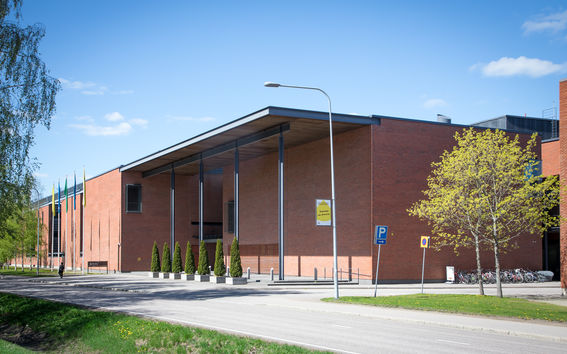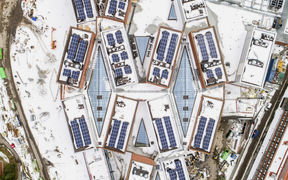Demand response for district heating in the Maarintie 8 building

On the basis of a pilot project for demand response for district heating carried out in winter 2014–2015, demand response has not had any impact on indoor temperatures experienced by users. It has been estimated that nearly 30 MWh of energy was saved.
In October 2014 – March 2015, Fortum and Aalto University Campus & Real Estate (Aalto CRE), in collaboration with Aalto University, carried out a pilot project for demand response for district heating in the Maarintie 8 building.
The aim of the project was to identify what impact savings in district heating, i.e. the use of demand response, have on indoor temperatures and user satisfaction.
Demand response to even out temporary peaks in consumption
Demand response can be used to even out temporary peaks in the consumption of district heating and, therefore, to reduce the use of heat plants that use fossil fuels. Similarly, it is also possible to time heating systems so that heat is consumed when it is the most affordable.
When using demand response for district heating, it is possible to temporarily adjust the temperature of supply water in the radiator network by pre-defined degrees. During the pilot project, the water temperature was lowered by 5–20 °C for 1–4 hours at a time.
The duration of demand response was mainly two hours and the variation in temperature was 5–15 °C. At the highest, the water temperature in the radiator network was lowered by 20 °C for two 4-hour periods per day.
The project used a new smart heating control system (Fidelix). The control system adjusts the temperature of supply water in the radiation and ventilation networks, obtains information about the outdoor temperature using a separate measurement and acquires the prices of district heating for the next day once a day.
Next, the system controls the temperature of supply water in the radiator network at a specific time in accordance with pre-defined temperatures.
Indoor temperature
Temperature information was saved from the building automation system of the Maarintie 8 building using a sampling interval of 20 minutes. A total of 195,090 samples of room temperature measurements were recorded from 15 offices.
In addition, 143,066 samples of other temperature measurements from the heating network and outdoor and supply air were recorded.
Moreover, the operational temperature of six rooms was recorded over a one-month period using a sampling interval of 10 minutes. In total, there were 12,629 samples of operational temperature measurements.
The aim of the measurements was to identify how the temperature information obtained from the TAC system corresponds with the temperature experienced by users. Operational measuring devices were positioned as close to the actual workstation of each user.
Location impacting speed of demand response
On the basis of the temperature measurements, demand response had only minor impact on temperature variation in the coldest rooms on different floors or on average temperatures of different floors. The highest impact demand response had on room temperatures was 1.04 °C. It should also be noted that the specific winter was exceptionally warm.
However, there is a clear difference between the 15 rooms being monitored in what impact demand response had on their room temperatures. In seven rooms (corner offices mainly), the room temperature changed much more quickly than in the other rooms.
In addition, there were clear differences in decreases in room temperatures depending on the time when demand response was used. As a result of this variation, it is estimated that any changes in temperatures resulting from demand response are highlighted in certain rooms due to the outdoor temperature.
Standard deviation in operational measurement results was higher than in the measurements of the TAC system in all six cases being monitored. Therefore, the temperature experienced by users changes more than what the measurement results of the TAC system indicate.
There was noticeable variation in the room temperature on working days, especially when no demand response was used. This variation in the room temperature probably results from the operation of the air conditioning system, other heat sources, such as people and computers, and any high variation in the outdoor temperature.
User satisfaction
The satisfaction of users with temperatures was monitored on a monthly basis by using an online satisfaction survey and a “Happy-or-not” feedback device located in the lobby. The “Happy-or-not” device registered 3,957 pushes of a button and the satisfaction survey collected 139 responses.
The survey did not show any direct link between demand response and user satisfaction. User satisfaction was at its highest during the most extensive use of demand response (-15 °C and -20 °C), while user satisfaction was at its lowest during demand response of -5 °C. Demand response of -10 °C did not cause any differences from the normal situation.
Considering user satisfaction, the operation of the building automation system, correctly set values and temperature changes resulting from other factors seem to be more significant. What is more, user satisfaction shows great variation depending on the personality of the person giving feedback and the location of the workstation.
'We need to evaluate savings on a building-specific basis in the long term. It is also decisive both from the perspective of Aalto CRE and Fortum that there are enough buildings participating in demand response. This will enable significant savings in heating costs while making demand response a part of the optimisation of heat production,' says Susanna Huuskonen, customer manager in the Espoo region at Fortum.
'Users of the Maarintie 8 building participated actively in the pilot project and gave valuable feedback on the indoor temperature. On the basis of their responses, demand response was possible without having any impact on user experiences. The active participation of the user representative in the steering group of the pilot project was a precondition for the smooth progress of the project,” says Satu Kankaala, head of workplaces and sustainability at Aalto CRE.
The project results showed that savings in both energy consumption and costs can be achieved by means of demand response without compromising on the comfort of use. The pilot project also demonstrated how important cooperation is in developing energy efficiency.
Sustainable campus
The key environmental impacts of the campus are related to energy consumption and transport. A sustainable and carbon neutral campus is at the core of the campus strategy.







